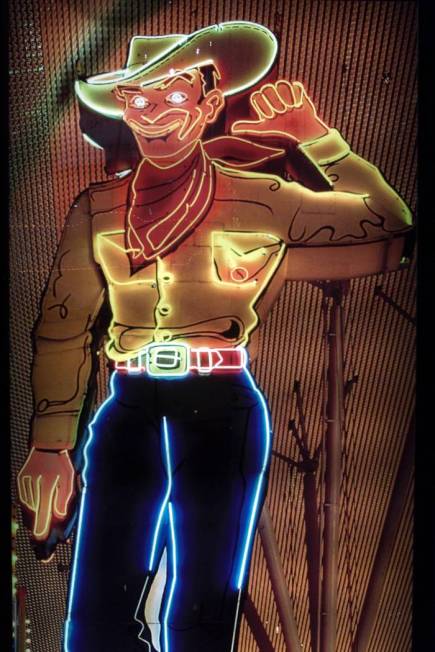New exhibit pays tribute to iconic Vegas Vic

It began with a cigarette and a wink.
One of the greatest promotions in a city of great promotions was just a face and a head at first, bereft of a name or a torso.
The Smiling Cowboy, they called him.
The year was 1945.
That’s when the Las Vegas Chamber of Commerce hired New York City’s J. Walter Thompson advertising agency to create a symbol, a character, something to represent and personify the city, to lure still more people to what was becoming a burgeoning tourist destination.
“In those days, Las Vegas was still promoting itself as an Old West theme,” says Dennis McBride, director of the Nevada State Museum, citing properties such as the Frontier and the El Rancho. “You think of Las Vegas as a concept, of this great gambling mecca, this oasis in the desert, but people need to associate that with some thing, some physical object.”
And that became Vegas Vic.
“J. Walter Thompson’s people came back with this wonderful figure,” McBride explains. “They felt that he embodied the kind of laid-back friendliness that Las Vegas was trying to promote. It was something that they felt that people could relate to. He began to appear in print ads all across the country, billboards, stationary, brochures, all kinds of things.”
As much as the Betty Willis-designed “Welcome to Fabulous Las Vegas” sign or a handful of commemorative poker chips, Vegas Vic has become an instantly identifiable totem of Las Vegas.
Now Vic is the subject of a new exhibit at the Nevada State Museum, Las Vegas, where a slew of Vic memorabilia, from lighters to ashtrays to pennants to bars of soap, recently went on display in its Curator Canyon.
They’re all culled from the collection of Richard and Nancy Greeno, an Indiana couple who have compiled around 10,000 pieces of Vegas-branded items since the ’60s, donating their treasure trove to the museum in 2015.
As he was sorting through box after box of knickknacks, McBride came upon a large assortment of items bearing the iconic visage of Vegas’ most famous cowboy.
All of which spurs the question, just who was he?
“People don’t really know much about the story behind Vegas Vic,” McBride notes. “So that was the purpose behind putting the Vegas Vic exhibit together, to let people know: This is where he came from.”
A neon icon is born
He was as big and noisy and colorful as his new home.
Vegas Vic came to life in earnest in 1948, when the since-shuttered Pioneer Club on Fremont Street acquired the rights to The Smiling Cowboy.
They then constructed what was, at the time, the largest neon sign in Nevada, shaped in the cowboy’s likeness and placed atop a building across the street from the property with a big arrow pointing toward the Pioneer Club to help drive traffic there.
Three years later, Vegas Vic would get both his name and some legs, becoming a full-length, 40-foot cowboy affixed to the outside of the casino, which is now a souvenir shop.
He’d get a voice as well.
“They made great use of him,” McBride says. “He started talking, ‘Howdy pardner,’ and his arm would go back and forth with his thumb out, ‘Come to the Pioneer Club, visit Las Vegas,’ this is who we are, this is what we do. He said, ‘Merry Christmas;’ ‘Erin Go Bragh’ on St. Patrick’s Day.”
He was also used for public service.
“In the 1960s, the health district put a mobile X-ray van just off Fremont Street to give people free chest X-rays to check for tuberculosis, which was far more common then,” McBride says. “So Vegas Vic was advising people to go around the corner and get a free chest X-ray.”
McBride knows all of this firsthand: His mother took him to get one when he was a kid.
Smaller hat, bigger legacy
In the decades since, Vic has occasionally fallen into disrepair and had to be refurbished.
He stopped talking in 1968, when the Las Vegas City Council silenced him after hotel guests continually complained about the volume of his 24-hour greeting — legend has it that actor Lee Marvin, staying downtown while shooting a film, was among Vic’s more vocal detractors.
And when the Fremont Street Experience was built in 1995, a few feet had to be shaved off the brim of Vic’s hat so that he’d fit under the canopy.
But other than that, little has changed about the neon cowboy who’s welcoming grin has endured for decades, an invitation to visit Vegas that tens of millions have heeded.
“I always found it fascinating that rather than simply taking him down and trashing him, they saved him,” McBride says. “He’s still a potent symbol, now of a lost era, but still associated with the town.”
About this town: It’s one defined by perpetual evolution, the old constantly giving way to the new. This is how Vegas prospers, by being ahead of the curve. But in the race to continually reimagine its future, Las Vegas can sometimes lose sight of its past.
This is where a certain four-story cowboy comes in.
“Not only is he a really important icon for Las Vegas, he sort of gives us a sense of historical continuity, which really lacks in this city,” McBride says. “Through all the changes, all the themes, all these ways that Las Vegas has remade itself, always standing constantly above all of that has been Vegas Vic.”
Contact Jason Bracelin at jbracelin@reviewjournal.com or 702-383-0476. Follow @JasonBracelin on Twitter.